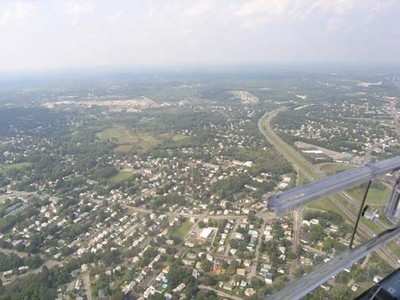Fly The Consumer-Friendly Skies
By ANN Correspondent Annette Kurman
"Now you can!" That was the message conveyed throughout the day
Saturday, September 9 at Lawrence Municipal Airport (LWM) as
upwards of 400 pilots and aviation enthusiasts converged on the
airport's flight line to inspect entries into the new class of
light sport aircraft approved by the FAA two years ago.

Just one of eight stops across the country, the weather was
perfect for individuals from around the Eastern Seaboard to fly or
drive in for a day of lectures, a free flight in a Flight Design
CWST, and a look at the newest entries into the LSA category. EAA
Chapter 106 hosted the EAA Sport Pilot Tour (alas, with not a rock
star in sight).
According to Ron Wagner, manager, EAA field relations, in a talk
held in a hangar to an audience of primarily men, many of AARP age
(keep in mind that the AARP ropes you in at age 50 these days), the
new sport pilot certification makes the dream of aviation "more
readily available to everyone and lowers the barriers..." by
decreasing the time in which one can secure a certificate, the
expense of securing that certification, and the cost of acquiring a
new aircraft.

Wagner stressed the LSA category also retains the safety that
every certification requires.

Listen To Ron Wagner's Views On Sport Pilot Here
As most everyone with an interest in sport piloting knows, a
valid driver's license can put you in the seat of one of the new
LSAs. Every pilot, no matter what the certification, self-certifies
his medical condition before flying, and a sport pilot -- even one
who secured his certificate through a valid driver's license -- is
no different.

Said Vermont resident Albert Oglesby, one of the three Green
Mountain Staters who drove down for the event, "Pilots always 'self
certify' -- whatever medical (certificate) they have -- their
fitness to fly. There's not much difference with a Sport Pilot." He
agreed with the EAA's Ron Wagner, "if we abuse it (sport pilot
certificate), it will go away."
(From the EAA Sport Pilot Sourcebook, "As a pilot, it is your
responsibility to ensure that your current medical health in no way
jeopardizes the safety of a flight.")
It appeared those in attendance were very familiar with sport
pilot's privileges and limitations. Those privileges include:
flying during the day using VFR; three miles visibility; visual
contact with the ground; flying in uncontrolled, Class E and G
airspace; flying up to 10,000 feet MSL; not flying for compensation
(although you can share operating expenses with another person);
flying in only sport pilot eligible aircraft; flying solo or with
one passenger; flying production and experimental amateur-built
aircraft that meet the definition of a LSA; and cross-country
flying anywhere in the U.S.

Limitations: prohibited from Class A airspace; prohibited from
flying in Class B, C, or D airspace until further training and a
logbook endorsement from an instructor; no flights outside the U.S.
without prior permission from the foreign aviation authority; no
towing any object; no flights while carrying a passenger or
property for compensation, hire, or for furtherance of a business.
(EAA Sport Pilot Sourcebook)
Many of the more mature FAA licensed pilots were very interested
with medical issues, addressed in the workshop "Sport Pilot for the
FAA Licensed Pilots... Medical Issues."
Wagner's advice? Let your medical certificate expire. Don't go
in for a medical review if you think there may be issues that would
deny you your medical certificate.
"If you think you might not pass the medical, don't take it," he
offered. Wagner also recommended EAA members contact the EAA
medical board if they have specific issues they want to inquire
about.
However, he added, "we all need to exercise good judgment in
using our drivers' licenses instead of a medical." Any pilot, he
said, should only fly when they're sure they are medically able to
fly. Every time someone flies who shouldn't, they jeopardize it for
everyone else."

At this time, in the "growth and implementation stage" of the
Sport Pilot certificate, there are some 400 recorded Sport Pilot
licenses. That number is expected to grow into the thousands as
more people become aware of the opportunity. "The skies the limit,"
he said, particularly one a major manufacturer comes on board.
Currently most of the LSAs are European made, primarily from
Germany and the Czech Republic. Many voiced a hope that Cessna will
soon jump into the fray.
According to EAA member and private pilot Brian Rugg, "I think
Sport Pilot is the most exciting thing that has happened in
aviation for more than 40 years. It's been a real 'grass roots'
effort."
All along the flightline you could hear wishful men saying, "I
wish I had my checkbook with me (to buy a LSA) and not tell my
wife."
Connecticut's Doe and Art Simmonds, both private pilots, were
very interested in light sport aviation. "Only problem," said Art,
"is that you can't find an airplane."
While saying this in front of eight to 10 LSAs on display --
courtesy of the LSA Marketing Group and its president, Dan Johnson
-- what they say is true, to an extent. Said Johnson, "Demand
currently does exceed supply."

Additionally, many would-be sports pilots voiced their
frustration with finding a flight school. Wagner acknowledged that
Sport Pilot is in its infancy and schools are hard to come by. That
will change, he promised.
(Part Two of this series, in which Annette takes the
controls of an LSA, will follow Monday. -- Ed.)
 Classic Aero-TV: Extra Aircraft Announces the Extra 330SX
Classic Aero-TV: Extra Aircraft Announces the Extra 330SX Aero-News: Quote of the Day (11.15.25)
Aero-News: Quote of the Day (11.15.25) ANN's Daily Aero-Term (11.15.25): Middle Marker
ANN's Daily Aero-Term (11.15.25): Middle Marker NTSB Final Report: Lancair 320
NTSB Final Report: Lancair 320 Airborne 11.14.25: Last DC-8 Retires, Boeing Recovery, Teeny Trig TXP
Airborne 11.14.25: Last DC-8 Retires, Boeing Recovery, Teeny Trig TXP







